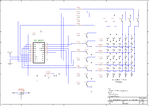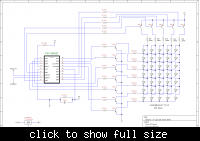indignantduck
Newbie level 4
Hi, electronics newbie here;
I'm trying to create a monocolor LED matrix of 11x11 using 74hc595 shift registers.
I'm using this schematic I found as a starting point: https://www.edaboard.com/attachment.php?attachmentid=79241&d=1346161224&thumb=1&stc=1
From my understanding, how this works is that you start off with everything disconnected. You send a high signal to the PNPs of each column corresponding to the LEDs you want on. Then you send a high signal to the first row (the NPN transistor). Then, since the LEDs of the first row are connected to ground, the LEDs which have current through them are turned on. Then you disconnect everything, do the same thing for the second row, etc.
I'm having trouble understanding how to calculate the values I need for the transistors. I understand I will need 11 PNP transistors for the anode and 11 NPN transistors for the cathode? Since it is row scanning, in my case, each NPN transistor has to sink up to 11x 20mA (assuming 20mA required to turn on each LED) = 220mA ? Is this right?
Also, each PNP transistor has provide current for 1 LED at a time, so it has to source 20mA? I've been doing a bit of reading online and many sites have been saying that the anode needs to be given 20mA x number of LEDs, but I just don't see why.
So, what values should I be looking for on the transistor data sheet before I go buying them?
Thanks
I'm trying to create a monocolor LED matrix of 11x11 using 74hc595 shift registers.
I'm using this schematic I found as a starting point: https://www.edaboard.com/attachment.php?attachmentid=79241&d=1346161224&thumb=1&stc=1
From my understanding, how this works is that you start off with everything disconnected. You send a high signal to the PNPs of each column corresponding to the LEDs you want on. Then you send a high signal to the first row (the NPN transistor). Then, since the LEDs of the first row are connected to ground, the LEDs which have current through them are turned on. Then you disconnect everything, do the same thing for the second row, etc.
I'm having trouble understanding how to calculate the values I need for the transistors. I understand I will need 11 PNP transistors for the anode and 11 NPN transistors for the cathode? Since it is row scanning, in my case, each NPN transistor has to sink up to 11x 20mA (assuming 20mA required to turn on each LED) = 220mA ? Is this right?
Also, each PNP transistor has provide current for 1 LED at a time, so it has to source 20mA? I've been doing a bit of reading online and many sites have been saying that the anode needs to be given 20mA x number of LEDs, but I just don't see why.
So, what values should I be looking for on the transistor data sheet before I go buying them?
Thanks

